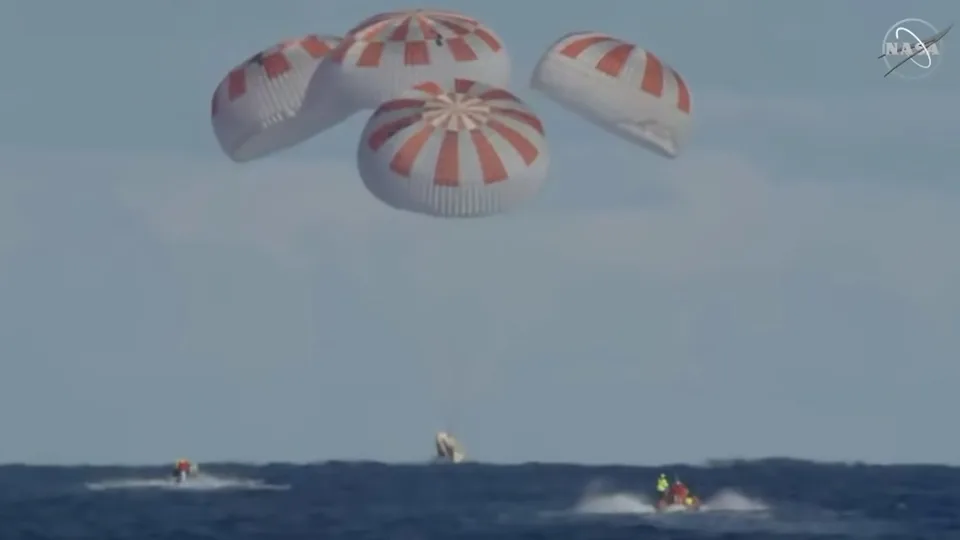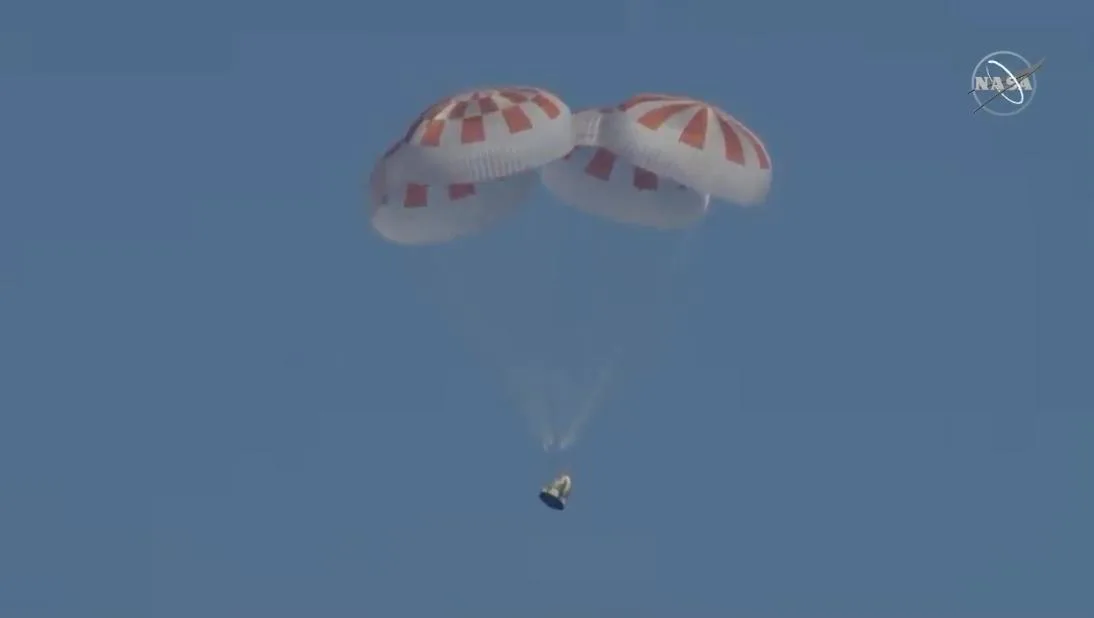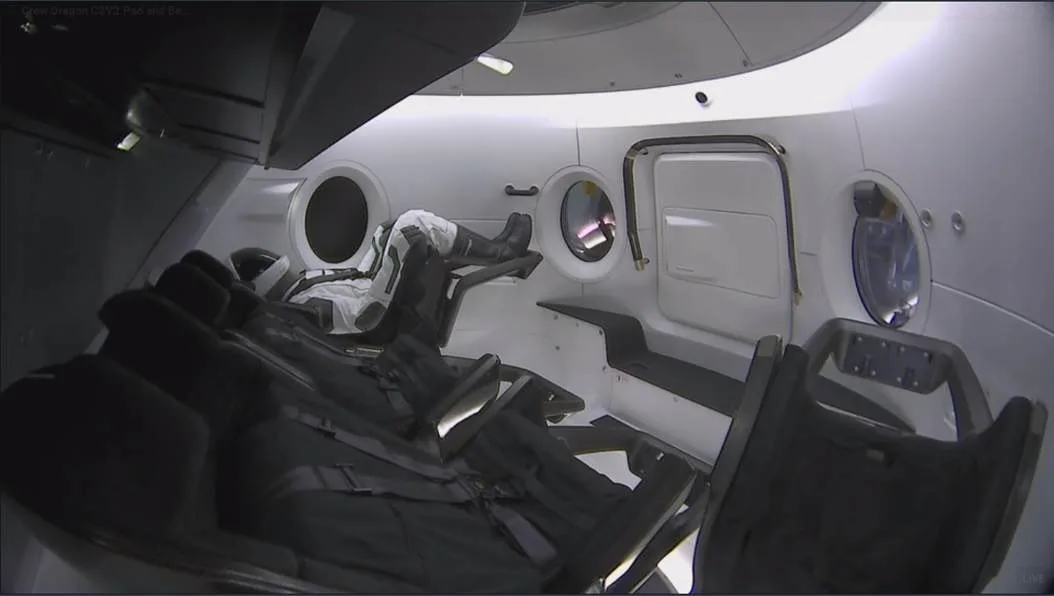
Crew Dragon successful splashdown ends perfect test flight
SpaceX's Crew Dragon spacecraft splashed down on Friday morning, successfully completing its inaugural test flight to the International Space Station.
With the completion of this first full test of SpaceX's crew-rated spacecraft, the private company is now one step closer to launching astronauts from U.S. soil.
The Crew Dragon lifted off on its inaugural, uncrewed flight - named Demo-1 - at exactly 2:49 a.m. ET, on Saturday, March 2.
Watch the launch again, below.
Early in the morning on Sunday, March 3, at 5:51 a.m. ET, the spacecraft successfully docked with the International Space Station, in the first autonomous docking maneuver performed by a SpaceX craft. This is also the first use the International Docking Adapter, since NASA astronauts Jeff Williams and Kate Rubins installed it, during a spacewalk back on August 19, 2016.
On Friday morning, after spending the past five days attached to the space station, Crew Dragon autonomously separated from it, moved away under its own power and control, and then returned to Earth, descending for a splashdown in the Atlantic Ocean, on schedule, at 8:45 a.m. ET, March 8, 2019.
"We were all very excited to see re-entry, parachute and drogue deploy, main deploy, splashdown – everything happened just perfectly. It was right on time, the way that we expected it to be. It was beautiful," said Benji Reed, director of crew mission management at SpaceX, according to NASA.
Rather than a powered descent, as was originally teased in SpaceX's flight animations, nearly 4 years ago, the Crew Dragon floated down to Earth on parachutes.

The Crew Dragon capsule floats above the Atlantic Ocean, dangling at the end of its four main parachutes, on the morning of Friday, March 8, 2019. Credit: NASA TV/SpaceX
This design change was made due to problems with the feasibility of the capsule descending on rockets, although the Draco rockets are in place to be used in the event of an emergency abort during launch.
NOT JUST ANOTHER SPACE LAUNCH
SpaceX's launches have become almost routine.
We watch the Falcon 9 go up. We see the spacecraft atop the rocket continue on its merry way to the Space Station, or into near-Earth or geosynchronous orbit. The Falcon 9 first stage comes back down to Earth for a landing - either on a droneship at sea, or just south of where it lifted off from, at Cape Canaveral, Florida.
Rinse, and repeat.
It's all very spectacular to watch, of course, and it's amazing to see this rocket come down and stick the landing, nearly every single time. (Even the failures are pretty spectacular, in their own right!)
While, on the surface, Saturday morning's launch appears quite similar to previous Dragon capsule flights to the International Space Station, underneath there is a very important distinction.
This Dragon is not a cargo ship, packed from engines to airlock with supplies and equipment for the station crew. Instead, the spacious, modern interior of this spaceship is actually outfitted for transporting human crew and passengers!
Take a tour of the inside of the Crew Dragon spacecraft!
So, this very first flight to space, for this particular Dragon, was being watched very carefully during its entire trip - from the ground to orbit, from orbit to the ISS, and from the ISS back down to Earth.
Extra scrutiny is certainly warranted for the inaugural flight of any spacecraft, but in this case, there's a special significance.
If everything is found to have goes well with this flight, very soon, SpaceX will begin ferrying human crew and passengers to the International Space Station, for the first time from the United States since the Space Shuttle program shut down, nearly 8 years ago.
UNCREWED, BUT NOT ALONE
Since this is the first test flight of the Crew Dragon, there are no humans along for the trip.
This uncrewed flight is not empty, though. According to SpaceX, there is about 180 kg of cargo going up with it, a number of 'mass simulators' to stand in for the mass of human crew members that will fly on future launches, and one "anthropomorphic test device" or ATD, named "Ripley".

ATD Ripley, on board SpaceX's Crew Dragon spacecraft, March 1, 2019. Credit: SpaceX/Elon Musk
SpaceX says that Ripley - named after Warrant Officer Ellen Ripley of the Nostromo, who was portrayed by Sigourney Weaver in the 1979 sci-fi thriller Alien - is studded with sensors on its head, neck and spine, which will return crucial data to SpaceX controllers on the ground about the stresses human occupants would endure on this flight.
Elon Musk also added another "passenger" to the flight, shortly before lift-off.
This "zero-g indicator" acted as a passive signal to the control room personnel that the spacecraft has achieved orbit and the capsule was experiencing zero-g, simply by floating up off the seat.
CANADARM2 SAT THIS ONE OUT
Whenever a Cargo Dragon spacecraft arrives at the ISS, it goes through an assisted method of attaching to the space station, known as 'berthing'. Basically, it simply pulls up underneath the station, maneuvers in close, and then sits there, at 'station-keeping'. The Canadarm2 then reaches out, guided by a crew member, to take ahold of (aka 'grapple') the capsule, and draw it in, to attach it to one of the station's airlocks.
The Crew Dragon did not need the assistance of the Canadarm2, though. Instead, it simply 'docked' with the station, under its own power and control, in a maneuver known as a "soft capture".
According to NASA, upon arrival, the Dragon first demonstrated its autonomous maneuvering capabilities, by approaching to a distance of 150 metres away from the station, then stopping and backing away to a distance of 180 metres, and then coming in to a final distance of 20 metres before it began its docking sequence.
It has been a long wait for this flight to take place, and while we unfortunately won't get to see this spacecraft descend back to Earth on jets of fire (as we original saw in flight simulations), this still promises to be a historic event!
Sources: SpaceX | NASA | US Air Force | The Planetary Society
